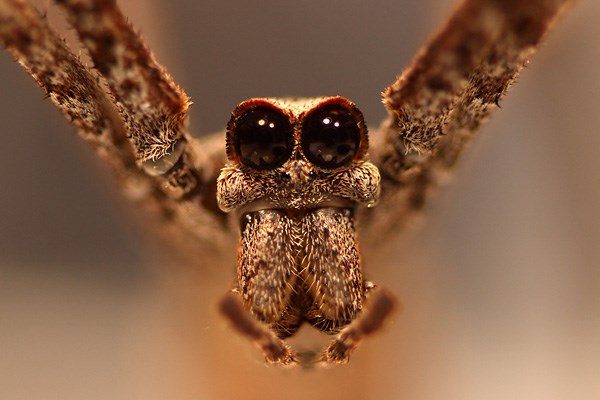Study Is Supported By $1.4M Grant from the National Science Foundation
 Image by Jay Stafstrom/Cornell University
Image by Jay Stafstrom/Cornell University
Some net-casting spiders have enormous eyes, which are among the most light-sensitive eyes on Earth and allow them to detect and catch prey in near-total darkness.
01/29/2022
By Edwin L. Aguirre
Spiders are a success story in evolution: They have been around for about 400 million years, and more than 48,000 species of them are distributed in almost every habitat on Earth. They are also expert hunters of insects, which they catch using webs spun from super-tough silk.
A team of researchers from UMass Lowell, Cornell University and the American Museum of Natural History is examining a family of spiders called Deinopidae to understand their specialized sensory system and ingenious use of webs, and to gain engineering insight into how these eight-legged creatures became so adept in detecting and capturing prey.
“Deinopid spiders are also known as net-casting spiders because they spin a small, rectangular web that they hold in their front legs while hanging upside down,” says Biology Assoc. Prof. Jessica Garb, who is the principal investigator for UMass Lowell.
“The spider waits for an insect to pass below it, and then rapidly expands and stretches this net over the prey – like a fisherman casting a net – before lunging forward to ensnare its prey,” she says.
Some net-casters have enormous eyes, which are among the most light-sensitive eyes on Earth, says Garb, who has extensive experience in researching spiders.
The latest study, which is funded by a three-year grant totaling more than $1.4 million from the National Science Foundation, aims to understand the genomic basis of these adaptations: What are the genes involved in making these super-stretchy webs? And what are the genes functioning in their eyes that allow these spiders to catch prey so quickly in near-total darkness?
Garb says the research will also involve a team of behavioral neurobiologists as well as mathematical modeling.
 Image by Jay Stafstrom/Cornell University
Image by Jay Stafstrom/Cornell University
Net-casting spiders spin a small, rectangular web that they hold in their front legs while hanging upside down. The spider waits for an insect to pass below it, and then rapidly expands and stretches this net over its prey before lunging forward to ensnare it.
The team will compare these spider types in terms of their genomics, behavior and ecology to understand how and why they differ.
Nature’s Wonder Fiber
While they may look delicate, spider silks are the toughest materials found in the natural world.
“They are tougher than steel or Kevlar, yet weigh much less, and some spider silks can be stretched up to three times their length without breaking,” Garb says.
Companies are trying to replicate these remarkable physical properties using genetically engineered spider silk for consumer, industrial, medical and military applications.
“The gene from a spider encoding silk protein is placed inside bacteria or yeast to produce the silk protein, which is then harvested and ‘spun’ in a factory by machines to produce fibers to make textiles and other products,” explains Garb.
 Image by Edwin L. Aguirre
Image by Edwin L. Aguirre
Another component of this web is a type of silk that has Velcro-like texture for extra adhesion.
“By characterizing the genes that encode these net-caster proteins, our work would allow biotech startups to genetically engineer large quantities of these biomaterials for commercial purposes,” Garb says.
In addition to its ability to withstand heavy loads, it has been discovered recently that spider silk can also perform as an extended acoustic sensor. “By examining how net-casters rely on their webs to sense flying insects by sound, our work can contribute to the development of miniature, biologically inspired microphones,” she says.
Another possible outcome of the research is that it could help in the development of technologies for detecting motion under very low-light conditions, Garb says.
Cornell University is the lead institution for the grant. Sandra Correa-Garhwal ’10, ’12, who is the principal investigator for the American Museum of Natural History, earned her bachelor’s and master’s degrees in biological sciences from UMass Lowell. She conducted her thesis research on spitting spiders in Garb’s laboratory at Olsen Hall on North Campus.
